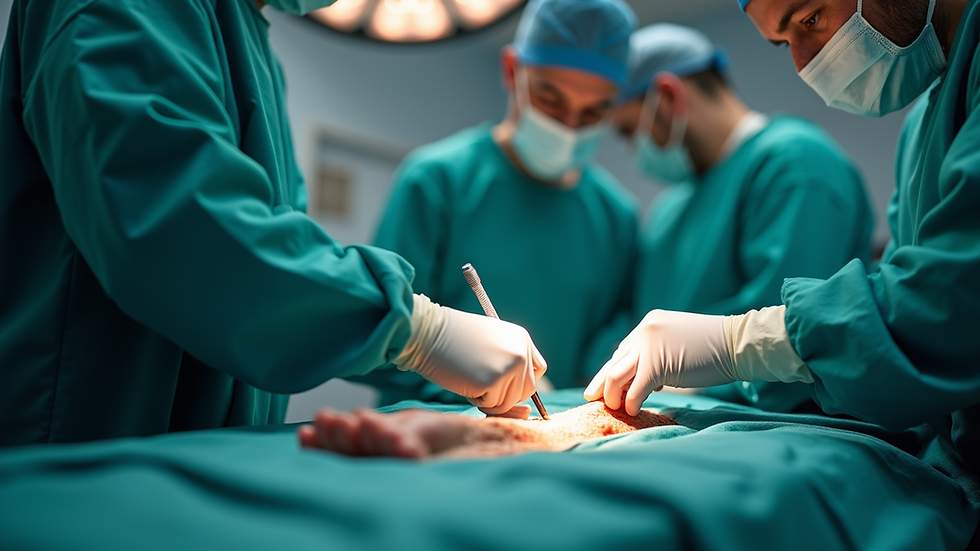Top Orthopaedic Surgeries at Sarojani Multispeciality Hospital
- Prashant B Bastawadi
- Jul 18
- 4 min read
When it comes to orthopaedic health, the right surgical intervention can make a world of difference. At Sarojani Multispeciality Hospital, patients have access to a range of advanced orthopaedic surgeries designed to restore mobility and improve quality of life. This blog post will explore some of the top orthopaedic surgeries offered at the hospital, highlighting their benefits, procedures, and recovery processes.
Understanding Orthopaedic Surgery
Orthopaedic surgery focuses on the diagnosis, treatment, and rehabilitation of musculoskeletal disorders. These disorders can affect bones, joints, ligaments, tendons, and muscles. Common reasons for surgery include injury, chronic pain, and degenerative diseases.
Patients often seek orthopaedic surgery when conservative treatments, such as physical therapy or medication, fail to provide relief. The goal of these surgeries is to alleviate pain, restore function, and enhance the overall quality of life.
Total Joint Replacement
One of the most common orthopaedic surgeries is total joint replacement. This procedure is often performed on patients suffering from severe arthritis or joint damage.
What is Total Joint Replacement?
Total joint replacement involves removing the damaged joint and replacing it with an artificial joint, known as a prosthesis. This surgery can be performed on various joints, including the hip, knee, and shoulder.
Benefits of Total Joint Replacement
Pain Relief: Most patients experience significant pain relief after surgery.
Improved Mobility: Patients often regain the ability to perform daily activities with greater ease.
Enhanced Quality of Life: Many report a better overall quality of life post-surgery.
Recovery Process
Recovery from total joint replacement varies by individual but generally includes:
Hospital Stay: Patients typically stay in the hospital for a few days post-surgery.
Physical Therapy: Rehabilitation begins soon after surgery to strengthen the joint and improve mobility.
Follow-Up Care: Regular check-ups are essential to monitor progress and address any concerns.
Arthroscopy
Arthroscopy is a minimally invasive surgical procedure used to diagnose and treat joint problems. It is commonly performed on the knee, shoulder, and ankle.
What is Arthroscopy?
During arthroscopy, a small camera (arthroscope) is inserted into the joint through tiny incisions. This allows the surgeon to view the inside of the joint and perform necessary repairs.
Benefits of Arthroscopy
Less Invasive: Smaller incisions lead to reduced scarring and quicker recovery.
Shorter Recovery Time: Many patients return to normal activities within weeks.
Less Pain: Patients often experience less postoperative pain compared to open surgery.
Recovery Process
The recovery process for arthroscopy typically includes:
Rest and Ice: Initial recovery involves rest and ice to reduce swelling.
Physical Therapy: A tailored rehabilitation program helps restore strength and mobility.
Gradual Return to Activities: Patients are encouraged to gradually resume normal activities as healing progresses.
Spinal Surgery
Spinal surgery is often necessary for patients with severe back pain, herniated discs, or spinal deformities.
What is Spinal Surgery?
Spinal surgery can involve various procedures, including discectomy, laminectomy, and spinal fusion. The specific procedure depends on the patient's condition.
Benefits of Spinal Surgery
Pain Relief: Many patients experience significant pain relief after surgery.
Improved Function: Surgery can restore mobility and function in the spine.
Enhanced Quality of Life: Patients often report a better quality of life post-surgery.
Recovery Process
Recovery from spinal surgery can be more complex and may include:
Hospital Stay: Patients may need to stay in the hospital for several days.
Physical Therapy: Rehabilitation is crucial for regaining strength and mobility.
Lifestyle Modifications: Patients may need to make lifestyle changes to support recovery.
Fracture Repair
Fracture repair is a common orthopaedic surgery performed to fix broken bones.
What is Fracture Repair?
Fracture repair can involve various techniques, including the use of plates, screws, or rods to stabilize the broken bone. The method used depends on the type and location of the fracture.
Benefits of Fracture Repair
Stabilization: Proper alignment and stabilization of the bone promote healing.
Pain Relief: Repairing the fracture often alleviates pain.
Restored Function: Patients can regain full function of the affected limb.
Recovery Process
The recovery process for fracture repair typically includes:
Immobilization: The affected area may be immobilized with a cast or splint.
Physical Therapy: Rehabilitation helps restore strength and mobility.
Follow-Up Care: Regular check-ups are essential to monitor healing.
Osteotomy
Osteotomy is a surgical procedure that involves cutting and reshaping bones. It is often performed to correct deformities or relieve pressure on joints.
What is Osteotomy?
During osteotomy, the surgeon cuts the bone and repositions it to improve alignment. This procedure is commonly performed on the knee or hip.
Benefits of Osteotomy
Pain Relief: Many patients experience significant pain relief after surgery.
Improved Function: Osteotomy can enhance joint function and mobility.
Delay Joint Replacement: In some cases, osteotomy can delay the need for joint replacement surgery.
Recovery Process
The recovery process for osteotomy typically includes:
Hospital Stay: Patients may need to stay in the hospital for a few days.
Physical Therapy: Rehabilitation is crucial for regaining strength and mobility.
Gradual Return to Activities: Patients are encouraged to gradually resume normal activities as healing progresses.
Conclusion: A Path to Recovery
At Sarojani Multispeciality Hospital, patients can find hope and healing through advanced orthopaedic surgeries. Each procedure is designed to address specific needs, helping individuals regain their mobility and improve their quality of life.
Whether you are considering total joint replacement, arthroscopy, spinal surgery, fracture repair, or osteotomy, the dedicated team at Sarojani Multispeciality Hospital is here to guide you through every step of the process. With a focus on patient care and recovery, you can trust that you are in good hands.
If you or a loved one is facing an orthopaedic challenge, do not hesitate to reach out to Sarojani Multispeciality Hospital. Your journey to recovery starts here.



Comments